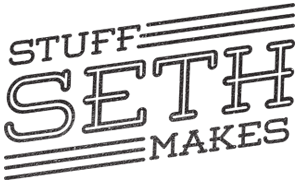This was one of those projects that made me think to myself “why didn’t I do this sooner??” But I guess I could answer that question by saying “because my carpet was super ugly and it wouldn’t look right!” So let’s jump into this project!
Disclaimer: As an Amazon Associate I earn from qualifying purchases. I appreciate you using my links and any revenue I earn helps me to keep creating content to share with you!
When my wife and I bought this house several years ago, the room we were planning to use for the office had QUITE the wallpaper. It was something I’d never seen before…chrome and baby blue florals. To say it was sight to behold would be an understatement. The baby blue paint didn’t help either…nor did the orange/rust colored carpet:
.jpg)
We got the wallpaper and paint taken care of pretty quickly when we moved in but we couldn’t afford new carpet right away. So we stuck with the light gray color we painted the walls and of course the orange carpet.
Fast forward 11 years and we’re finally getting rid of that old carpet and getting new carpet which, by the way, if you’re in the north country San Diego area (Carlsbad, Vista, San Marcos, Escondido, etc) I can highly recommend Tri-City Carpet in Vista. Gary is who we worked with and he really knows his stuff. We’re very happy with our new carpet (we’ve done 3 bedrooms, living room and family room with Gary). Definitely check with Tri-City Carpet if you’re looking to pull out the old and put in the new!
.jpg)
Anyway, we also updated our paint color and installed new, larger baseboards. Now the office was looking much much better, but it still needed something. Something to make it pop….some sort of cool factor. How about a feature wall?? Yes! That’s what we’ll do! But what do we want it to look like? We thought about doing a geometric line pattern, but I did one quick search and pretty much every DIY mom-blogger does that since it’s just 1×2’s and a miter saw. We actually did something like that for our wedding photography trade show booth a hundred years ago so for us, that look has been played out for quite a while:
.jpg)
But I’m not a mom-blogger so I had to come up with something better.
After looking through countless images and inspiration pics that weren’t all that inspirational we finally landed on something we liked that wouldn’t be overly complicated. Circles! Actually it’s half circles, and it’s a pattern inspired from a midcentury modern art poster of some sort. I knew this was a design I could cut out on my Shapeoko CNC and once I took some measurements and drew up the design in Carbide Create, I was off to the races!
.jpg)
The design is simple. It’s basically the letter “D” and by flipping and/or rotating the “D” I came up with a few different styles I would use. Within Carbide Create I also varied the pocketing toolpaths to remove or leave more or less material, which is what would give these 12×12 tiles their three-dimensional quality. I chose to use good ole’ MDF (1/2″ thick from Home Depot) for this project because of price and how easy the cnc can cut it. I would need 96 tiles in all (plus a couple spares just in case anything happened) so I powered up the Shapeoko, opened Carbide Motion and launched the gcode file. Now we wait, haha!
.gif)
While the cnc was cutting mdf tiles, I needed to do a little wall prep in the office for the new sconce lights I would be adding. Since we have no existing electrical in the spots where the new lights would go and I’m not comfortable running brand new electrical, I came up with an easy way to wire the new lights. Since this blog post is all about the wall, I’ll go into more detail on the lighting portion in my next blog entry.
Unfortunately I needed to do a little sanding on each tile after the cnc was done cutting. I believe that has something to do with my stepover settings, not the cnc machine or the router bit. So who do I call when I need a hand? My wife of course!
.gif)
Now that the tiles are all finished I can go ahead and start installing and attaching them to the wall. I’ll just be using an 18-gauge nailer for this. I’m also using a piece of 1/2-inch mdf as a spacer against the ceiling and side walls. This is because I’m going to use a long strip of 1/2 inch mdf as a border, or trim. There’s a little more explanation as to why I do this in the video. But once that’s all in place I can get setup for paint.
.jpg)
I’m going to use an airless paint sprayer for this wall because I don’t want to deal with a brush in all the corners and tighter spots. I’m hoping spraying will be the right choice. It’s not my first time using an airless sprayer however, it’s my first time “in a while”, haha! My father in law recently bought the Graco Magnum X7 to help a family member paint their house, and I could’ve easily borrowed that from him. The only thing is that it’s a 5 hour drive to his house (one way) so with gas prices being what they are (let’s go Brandon!) It was actually a better use of my money for me to buy the Graco Magnum X5 model on Amazon, which is a little smaller and perfect for this project. Now I have my own sprayer!
.jpg)
The instructions to use the Graco Magnum X5 are really simple and straightforward. I don’t have a ton of projects lined up where I’ll need to use the sprayer so I imagine I’ll have to reference the included Quick Start Guide every time. That’s okay though, I don’t mind. As is recommended, I shot some paint at a piece of cardboard first so that I could get my spray pattern dialed in. I should also mention that in addition to the sprayer I purchased the Graco TrueAirless 315 spray tip as well. This gives a narrower spray pattern that I thought would be better suited for this project. With the spray tips, the first digit represents half the width of the spray pattern, while the last two digits represent the hole size. So with the 315 tip, 3 is half of 6, so there’s a 6-inch fan, and the 15 means the hole is .015″ diameter. The Magnum X5 includes a 515 tip so that would be a 10-inch spray pattern with a .015″ diameter hole. Another example would be a 410 tip and that would give you an 8-inch pattern with a .010″ diameter hole. Capiche🤌🏻? I also picked up a Graco 15-inch extension wand to try out. If you’re looking for a LOT of info on painting and sprayers and tips and accessories and all that, I recommend you check out The Idaho Painter on YouTube. If I didn’t know any better I’d say he invented painting….period.
Moving on! My first coat went on pretty smoothly just as I had hoped and when I stood back and looked at it I was so impressed. Since the MDF tiles had some of the surface cut away to create the design, that exposed more of the core of the MDF which is more fibrous. The moisture of the paint “raised the grain” so to speak in these areas and I was left with a slightly “rough” texture there. From a distance it actually looked cool but what I didn’t like was the spots where I had use filler to cover the nail holes was smoother. That was a visual distraction to me, so I proceeded to get a little piece of 220 sandpaper and go after all the fuzzies. After that I hit it with a second coat with the Graco sprayer. Much better! I will admit, I got a run in the paint but it was in a spot that would be behind the tv when I’d mount it on the wall, I’ll never see it in the finished product so it’s all good! It will always be in the back of my head as a reminder though, and in future projects I may need to decrease the sprayer pressure, or move the sprayer a little quicker, or a combination of both. Bottom line is, I’m learning and getting practice and hopefully the next time I spray something it will be even better than this.
.gif)
With the wall tile installation complete, that meant I could finally move on to the sconce light installation. As I mentioned earlier I’ll have a separate blog entry on the sconce light hack and how I dealt with having no electrical in the spots where I planned to install the lights. But the finished feature wall/accent wall (whatever you prefer to call it) looks amazing and we’re really happy with how everything turned out. It’s a very rewarding feeling to complete a project that you’ve seen come together (and done yourself) from start to finish.
Pretty much everything I do is a learning experience and that’s a big part of the fun for me. If I ever do another project like this, I know I’ve learned a couple things on this one that will help to improve the next one, even if it’s just a little bit. I like to learn by doing What about you? I hope you thought this was a cool project. Be sure to check out the full video on my YouTube channel and when you watch the video, I’d love for you to give it a “like”👍🏻 and also leave a comment if you don’t mind! That really helps to get my videos in front of more viewers…..crazy algorithms, am I right? 🙂 Thank you for stopping by!
You can also find me (and my wife) at the following links:
My Instagram: @stuffsethmakes
My YouTube Channel: Stuff Seth Makes
My wife’s Instagram: @whatsupinthegarden
Our Gardening & Landscape YouTube Channel: What’s Up In The Garden
My Amazon Storefront: www.amazon.com/shop/stuffsethmakes
.







